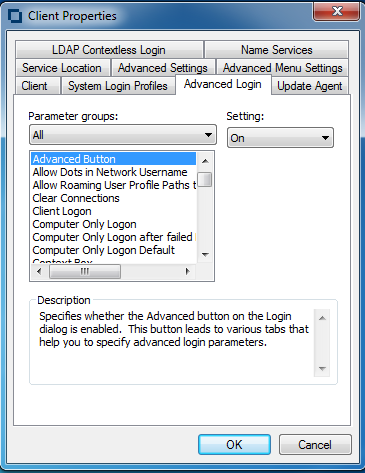8.3 Customizing the Client Login
The Login process can be customized to use the features that you want users to have access to. Customizing gives you control over the following:
-
NMAS authentication
NMAS authentication adds additional security to the network. However, if your network does not use NMAS, login might take additional time and you might want to disable NMAS authentication.
For more information, see “Disabling NMAS on the Server” in the Novell Modular Authentication Services 3.0 Administration Guide.
IMPORTANT:You can use the Install.ini file to control the installation of NMAS. In the [Setup] section of the Install.ini file, there are InstallNICI and InstallNMAS options. If you change these options to No (they are set to Yes by default), NICI and NMAS are not installed when you install the Client. See Section 2.3, Using the Install.ini File for more information.
-
Login dialog box customization
The dialog box can be customized to control the availability of certain login options. This gives you control over how users log in.
-
Advanced button
If you have set up several login profiles and do not want users to change the data in various login fields (such as Tree, Context, Server, and Run Scripts), you can hide the Advanced button.
-
Clear current connections check box
If you want all connections to be cleared every time users log in, or if you don’t want any connections to be cleared, you can set the value in the location profile and then hide the Clear current connections check box.
NOTE:The Clear current connections option is never visible during initial login, because an initial login automatically clears all connections.
-
Context field
If the Login dialog box is being used to log in to a specific tree, you can disable the Context field to prevent users from changing the context.
-
Contexts browse button
If the Login dialog box is being used to log in to a specific tree, you can disable the Contexts browse button to prevent users from changing the context.
-
Did you forget your password? prompt
This prompt gives users the ability to recover from a forgotten password without contacting the help desk. See Section 6.3, Using Forgotten Password Self-Service for more information on configuring the Forgotten Password feature.
-
Last logged on user
You can specify whether the last logged on user is displayed along with the Logon when a user logs on to a computer.
-
Login Profile drop-down list at the top of the dialog box
The Login Profile drop-down list can be set to Off (always hide the Login Profile list), On (always display the Login Profile list) or Automatic (only display the Login Profile list if it contains more than one Login Profile).
-
Tree field
If the Login dialog box is being used to log in to a specific tree, you can disable the Tree field to prevent users from changing the tree.
-
Trees browse button
If the Login dialog box is being used to log in to a specific tree, you can disable the Trees browse button to prevent the user from changing the tree.
-
Variables button on the Script tabbed page
If you use %2, %3, %4, or %5 in the login script, you might want to set these values in the location profile but not allow users to change them. In this case, it might be helpful to hide the Variables button.
-
To show or hide any Login dialog box option:
-
Right-click the Client Tray icon (
 ) in the notification area of the taskbar, then click Client Properties.
) in the notification area of the taskbar, then click Client Properties.
-
Click Advanced Login.
-
Select Show on Login in the Parameter groups drop-down list.

-
Select the parameter you want, then select On or Off in the Setting drop-down list.
A short description of each parameter is available in the Description field when you select the parameter. For more information, see Section 4.2.3, Advanced Login Settings.
-
Click OK.